[Publisher’s note: This will be David’s final article for BikePortland. Since he’s currently chair of the PBOT Bicycle Advisory Committee, the City of Portland said he would have to step down from that role if he wanted to write for us. He chose to continue being chair of the BAC. Thanks for sharing your insights David! And thanks for being a volunteer advocate on that important committee. – Jonathan]
If you’re wondering why it was necessary to require a 10-ft wide sidewalk on a local-access street while the local collector with a bus stop would be “adequately” served by a four-foot asphalt shoulder, all I can say is that’s a really good question.
This is the final piece of a three-part series on how SW Hamilton Street illustrates the many challenges to creating safe walking and biking facilities in southwest Portland. In the first part I gave some context for SW Hamilton, then in part two I shared an example of a typical City of Portland project on the street. While city projects have had an impact, redevelopment by private entities has presented an even more confounding situation.
Before we get any further, I want to add a couple of notes. I was Chair of Bridlemile Neighborhood Association (BNA) from May 2016 to May 2018 and served on the Board of Directors for a bit over four years in total. All of the projects in prior years garnered many opinions from board members and neighbors, some stronger than others. In this series I’ve leaned on public records documenting the decisions made along with what is on-the-ground today. Plans and other information that were not explicitly public were acquired and shared through third-parties who are also deeply invested in this neighborhood and its infrastructure.
It also needs to be said that there are many competing priorities throughout the city and expecting world-class facilities on every road is not reasonable with the transportation bureau’s $4 billion maintenance backlog. But when a property is developed, we often have a blank slate and a new pool of funds to provide something better just by adhering to existing policies that obligate developers to specific responsibilities. As you will read, the result if often a newer version of what’s already there, rather than holding a developer to a higher standard on behalf of the new residents that will eventually live on the property.
Advertisement
Lack of Sidewalks
Precedents are funny things. Sometimes they are set after community input and careful consideration, other times it’s an afterthought. The lack of sidewalks on Hamilton can be traced to two projects that exemplify the power of precedent.
The lack of sidewalks on Hamilton can be traced to two projects that exemplify the power of precedent.
You’ve already read about the first precedent, a bioswale project completed by the Portland Bureau of Environmental Services in 2016. They were able to extend the shoulders as part of the project because it was inexpensive and the stormwater mitigation that drove the project did not have to be expanded by keeping the right-of-way to only asphalt. The project left much to be desired by the neighborhood, they even wrote a letter that outlined their dissatisfaction. Now that ongoing maintenance has ended, the bioswales are overrun by invasive blackberries and foliage partially blocks the shoulder. Roads that have no curb are considered self-cleaning — meaning getting any kind of brush clearing is near impossible (that’s a story for another day).
The second precedent happened when the City of Portland enabled developers to build several million dollar homes while minimizing frontage improvements through a slick-land use maneuver. Back in 2016 a developer wanted to shift lot lines around to allow them to build four houses where two creeks meet amid Environmental Protection and Conservation overlay zones. These overlays are quite common in southwest Portland and are supposed to provide an extra layer of protection for sensitive areas. The lots were at the northeast corner of Hamilton and 58th Avenue, but the addresses all listed 58th Avenue rather than Hamilton St.
As a result of the address being on 58th Avenue rather than Hamilton, the frontage requirements were minimal. The initial decision by the city was that a sidewalk would be required on both sides of 58th and there would be no improvements on Hamilton. After appealing that decision, 58th was allowed to stay in its existing state with no improvements or even repaving. When the full environmental review decision was released all of this was already baked-in. Due to this being a land-use decision regarding environmental overlays and not development, the Bridlemile Neighborhood Association (BNA) was advised by city staff that appealing street improvements would be unsuccessful. As promised, BNA filed a detailed appeal which included disapproval of the frontage requirements that the city had approved and as expected the end result was in line with the developer’s request.
In the final decision Hamilton was described as “improved with a 22-foot-wide right of way, also without curbs or sidewalks.” It continues “[a] Public Works Alternative was approved by the Public Works Alternative Review Committee, which determined that standard frontage improvements would not be required along either SW Hamilton or SW 58th in relation to the construction of the four single-dwelling residences proposed for this site.”
There’s a lot to dissect within that last paragraph. SW 58th is one of many roads in southwest without curbs, sidewalks, or shoulders and this decision meant the status-quo would be maintained. Hamilton didn’t require any improvements either, however the developer agreed to PBOT’s request to extend the shoulder on the north side of the street. A final note is that the following statement also made it into the appeal “although frontage improvements along SW Hamilton and SW 58th will not be required at this time, they will be required in the future.” It is not clear if there is an enforceable mechanism to make this happen nor is there a timeline for this future requirement.
Advertisement
Subdivisions Arrive
Less than two years later, the house across the street, on a lot with over four acres of land, was ready to be replaced with a subdivision. While sidewalks would be installed inside the new development, only extended shoulders were necessary for Hamilton. While BNA had a stated desire to include sidewalks it quickly became clear this was not going to happen and the focus instead shifted in a new direction: contiguity.
BNA wanted the shoulders constructed at 58th Ave to connect with the ones that would be installed at the to-be-constructed 59th Ave. This would provide multiple blocks of continuous, connected shoulder space for people to walk, run, or bike (uphill) without having to cross the street which was signed at 30 mph at the time. Unfortunately, this proposal was scuttled by two forces; a property owner that didn’t want the shoulder on their side of the road and the city not being able to do anything to force the issue as it was outside the project scope.
This development is currently being constructed with houses being listed around $2 million each. The sidewalks that are present look nice and the curb ramps are already installed which will make it easier for people to access the neighborhood when they park in the shoulder. A feature of these shoulders is that not only can they facilitate people walking and on bicycles for short distances but there is no signage prohibiting parking so they are truly all-access. This hasn’t led to much conflict yet since only one or two of the houses appears to be occupied. But this could change in the coming years.
Moving on to the final development on our tour, 2018 was a busy year and a simpler land use decision next to Hamilton was also moving forward at 53rd Ave. A house had been removed from a larger lot and the request was to divide the lot into two parcels. No environmental overlays were present and 53rd already had curbs. As a result the improvements were as follows:
“Consistent with the Public Works Alternative approved for this site (17-270729-PW) required improvements within SW Hamilton will include: widening of the roadway shoulder by extending the existing paved roadway to provide a 4-ft asphalt shoulder; dedicate 14-ft of property for ROW purposes; and adequate conveyance of stormwater, if necessary as determined by BES, along the property frontage. Required improvements on SW 53rd will include construction of the 10-ft wide sidewalk corridor behind the existing curb.”
If you’re wondering why it was necessary to require a 10-foot wide sidewalk on a local-access street while the local collector with a bus stop would be “adequately” served by a four-foot asphalt shoulder, all I can say is that’s a really good question.
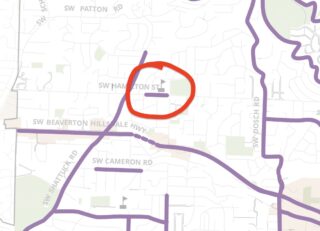
I get a bittersweet feeling when I look back on these developments, the projects by BES and PBOT, and all the gaps that remain. I was part of fighting the good fight, seemingly losing at every turn to the whim of budget or policy decisions. Still, conditions have improved from their prior state and if the Southwest in Motion project on Hamilton (BP-43, which calls for a new sidewalk from 48th to 45th outside Bridlemile Elementary School) is actually implemented there might even be a new sidewalk to make that last connection to school a little less stressful. New development will continue as well, it’s too lucrative for property owners to ignore forever. And while it may take decades to happen, eventually the gaps will become small enough that it will become more feasible to fill them in.
I hope you enjoyed this series! It gives you just a little window into what it takes to be an advocate for better streets in southwest Portland. Sort of like riding a bike, the climbs are tough, but when you get to the top it’s well worth it.
For more about why there are so few sidewalks in southwest (and east) Portland, see this previous article by Lisa Caballero: Sidewalks and Portland, it’s not so simple.


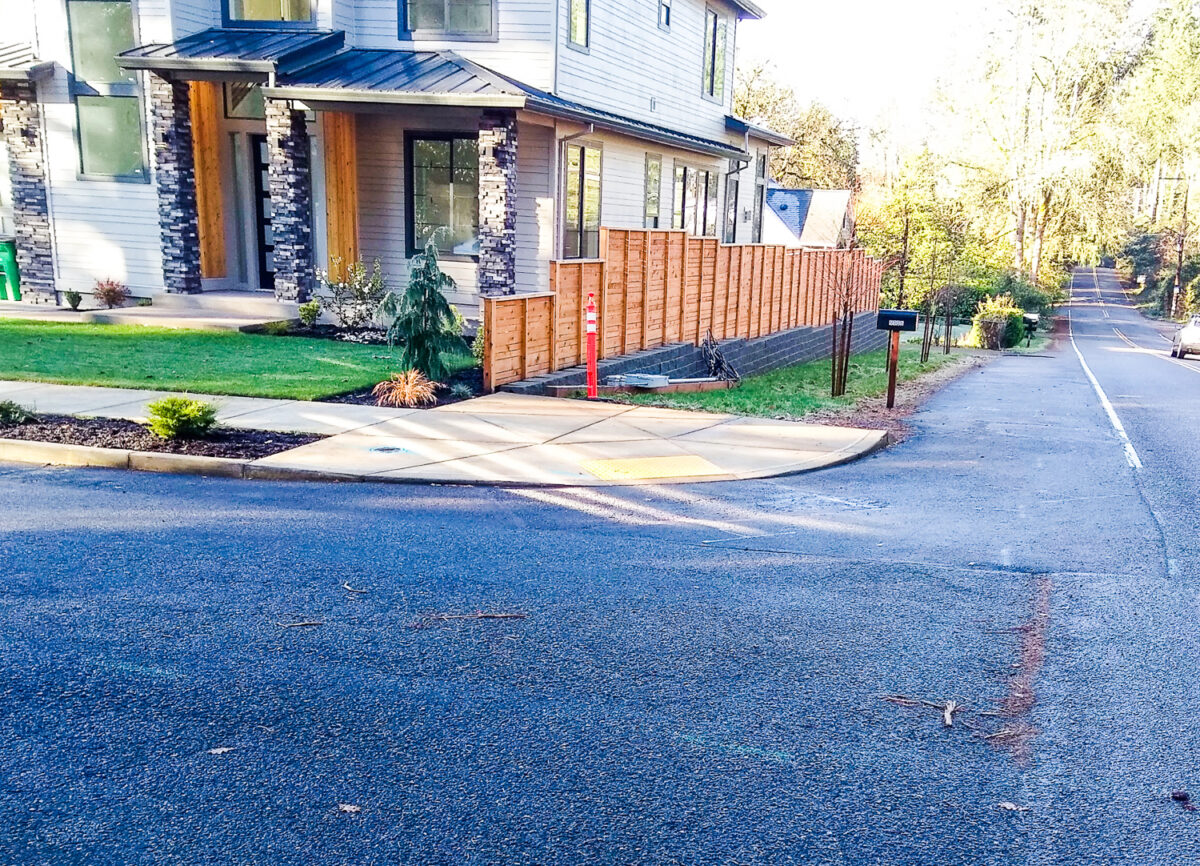
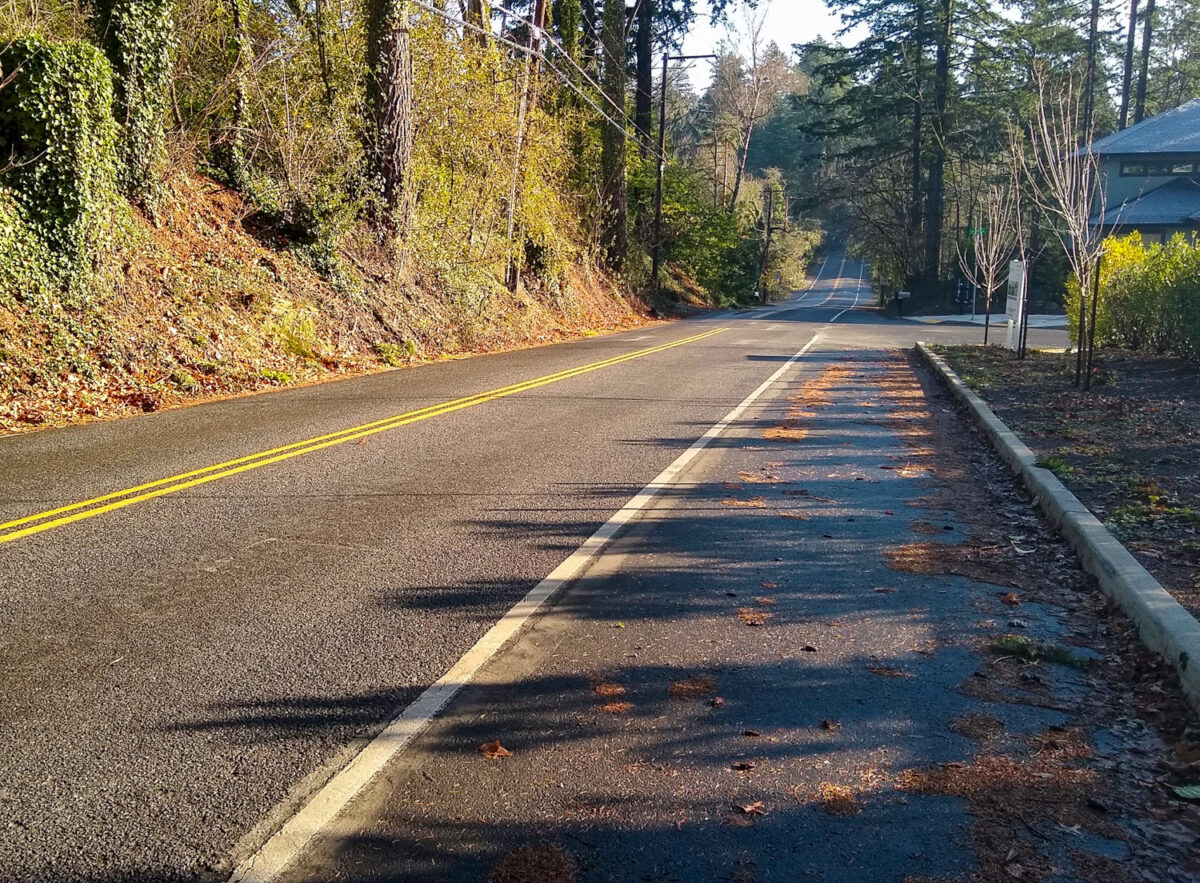
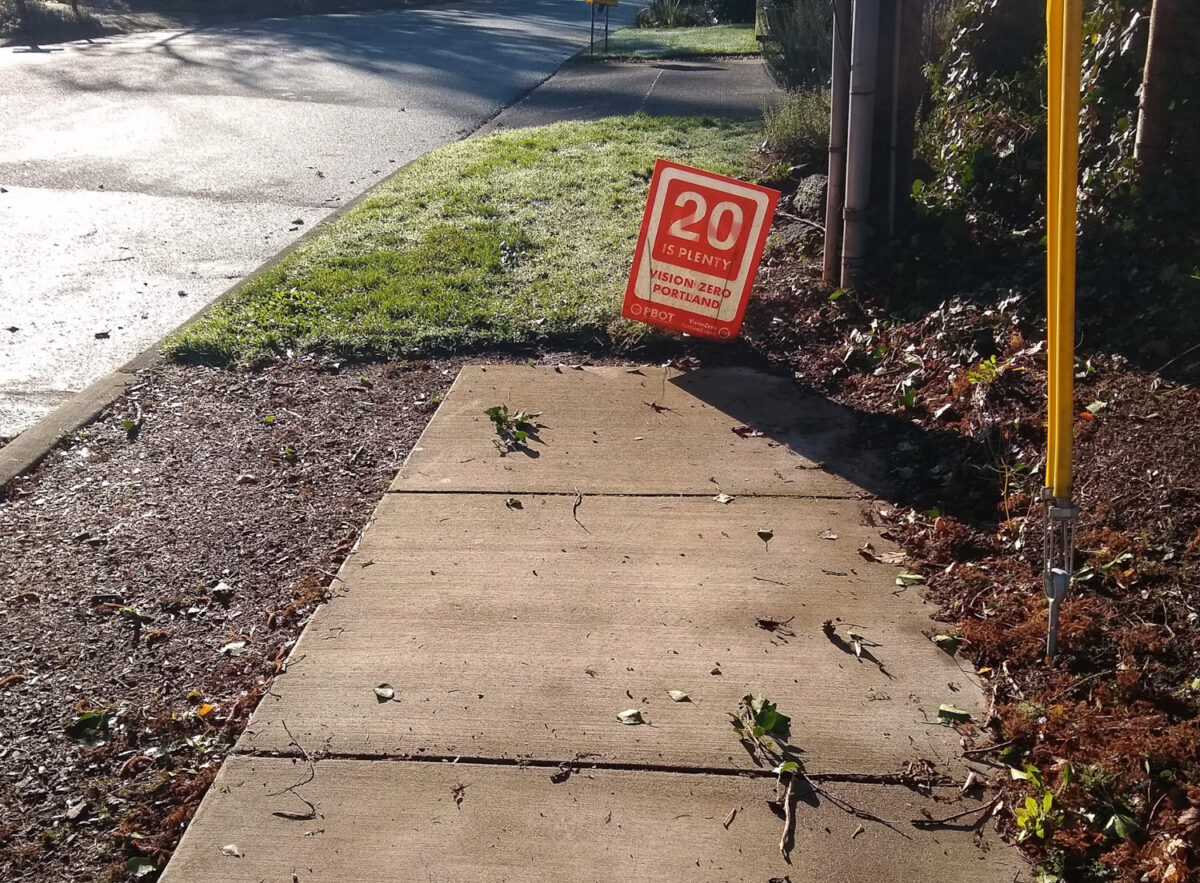
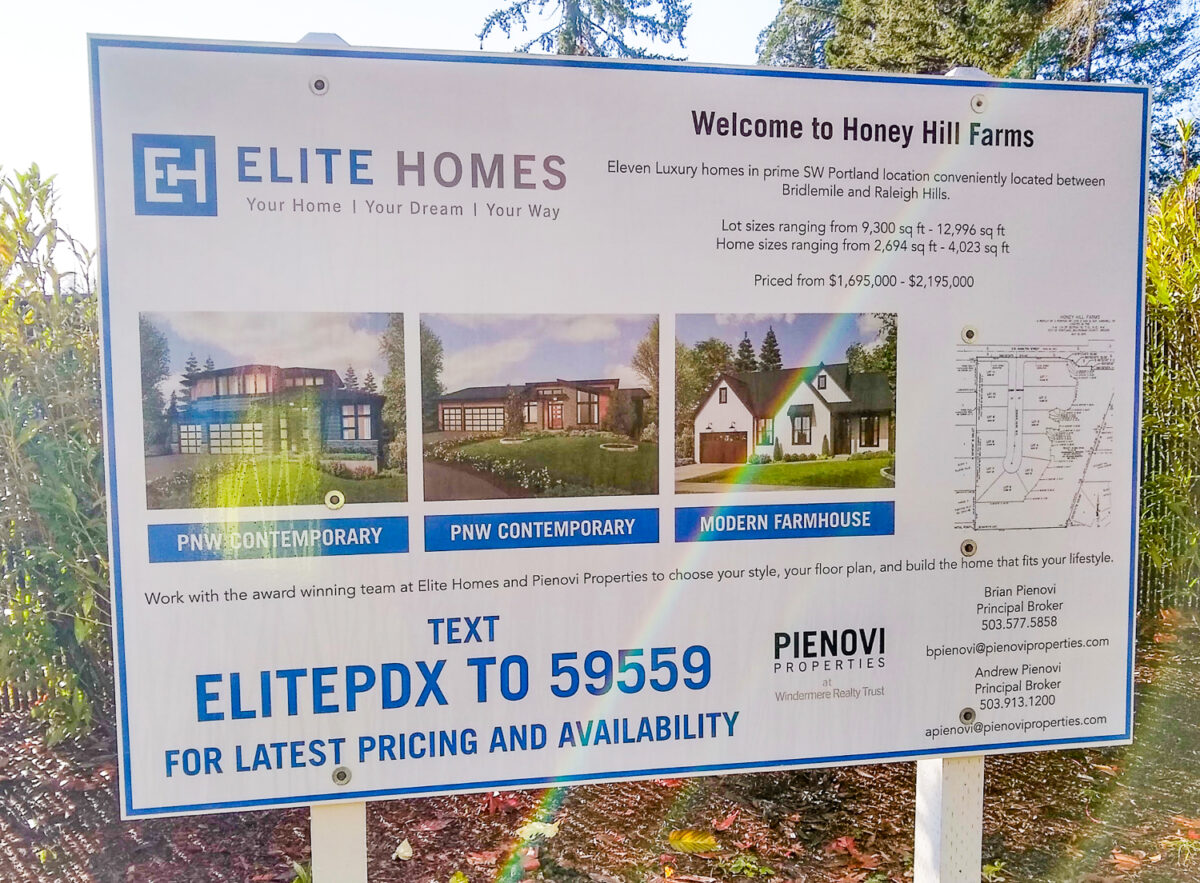
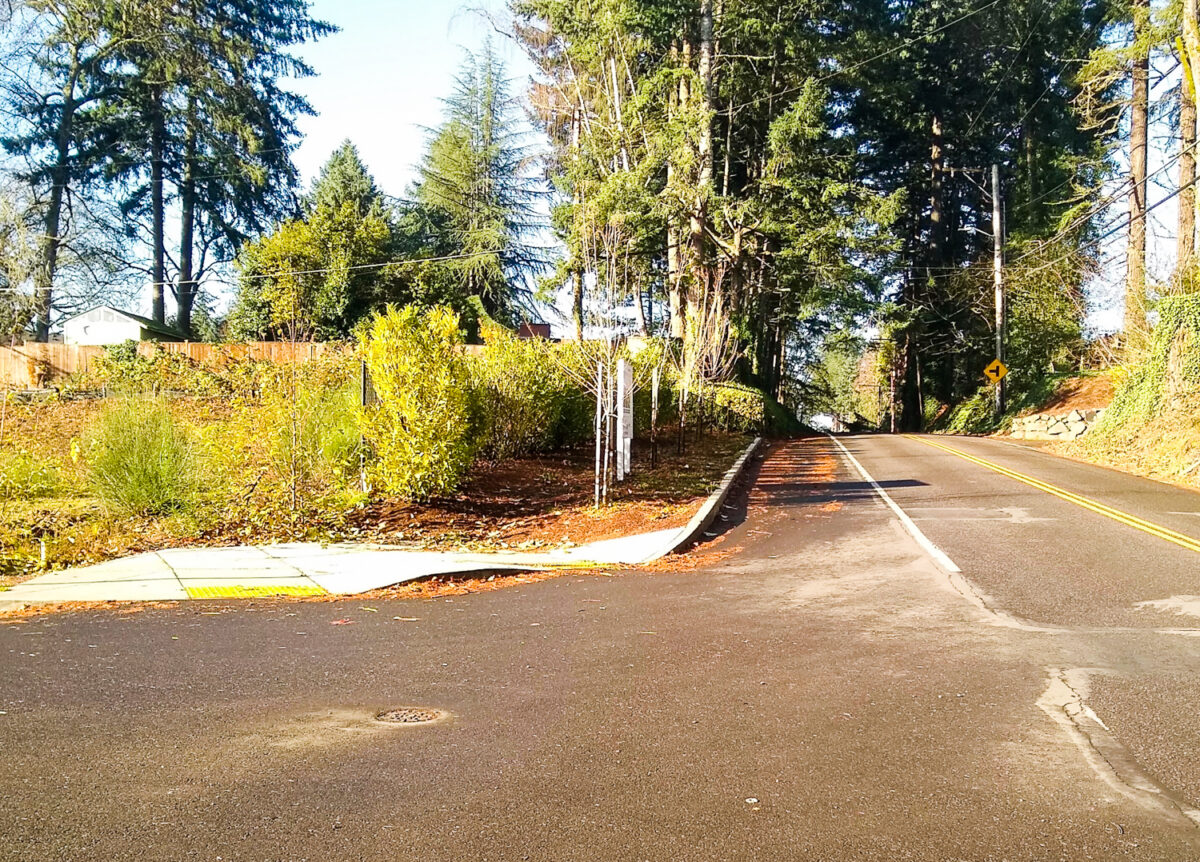
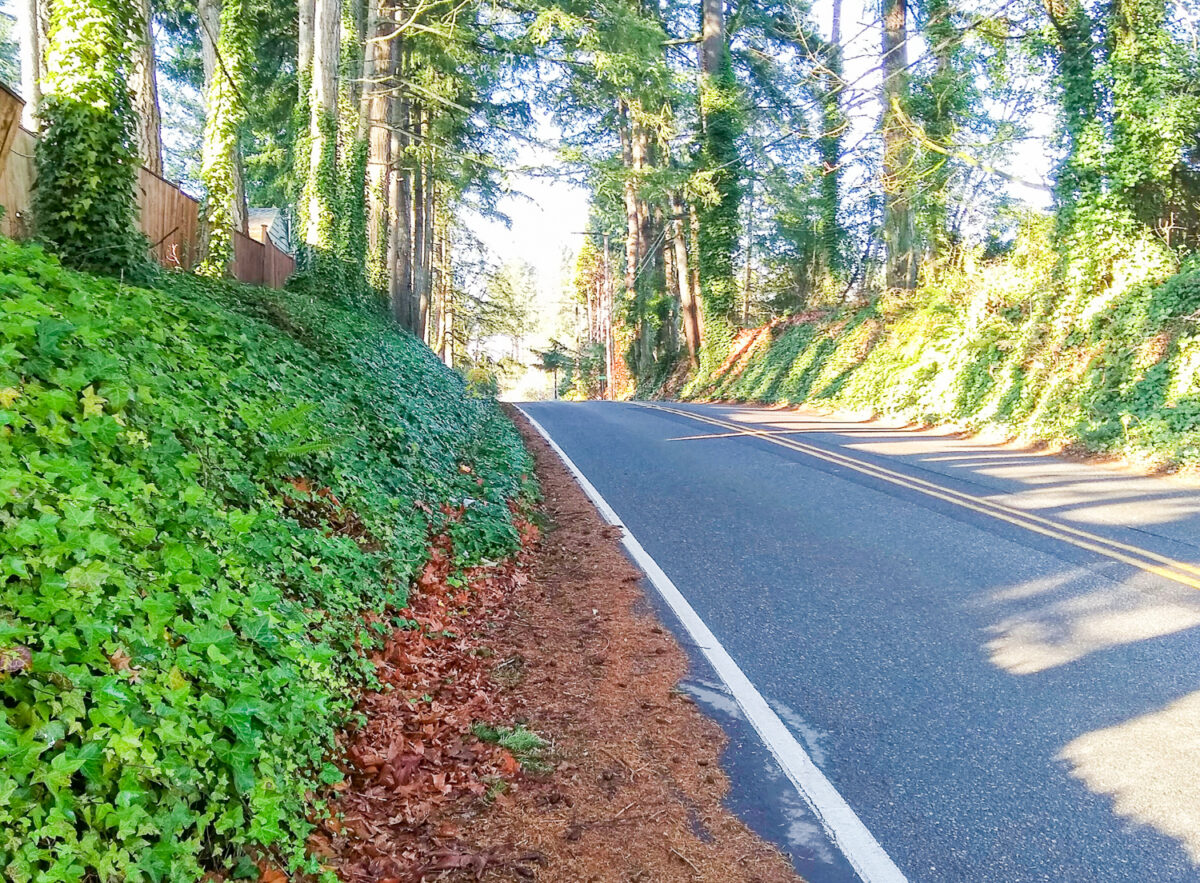
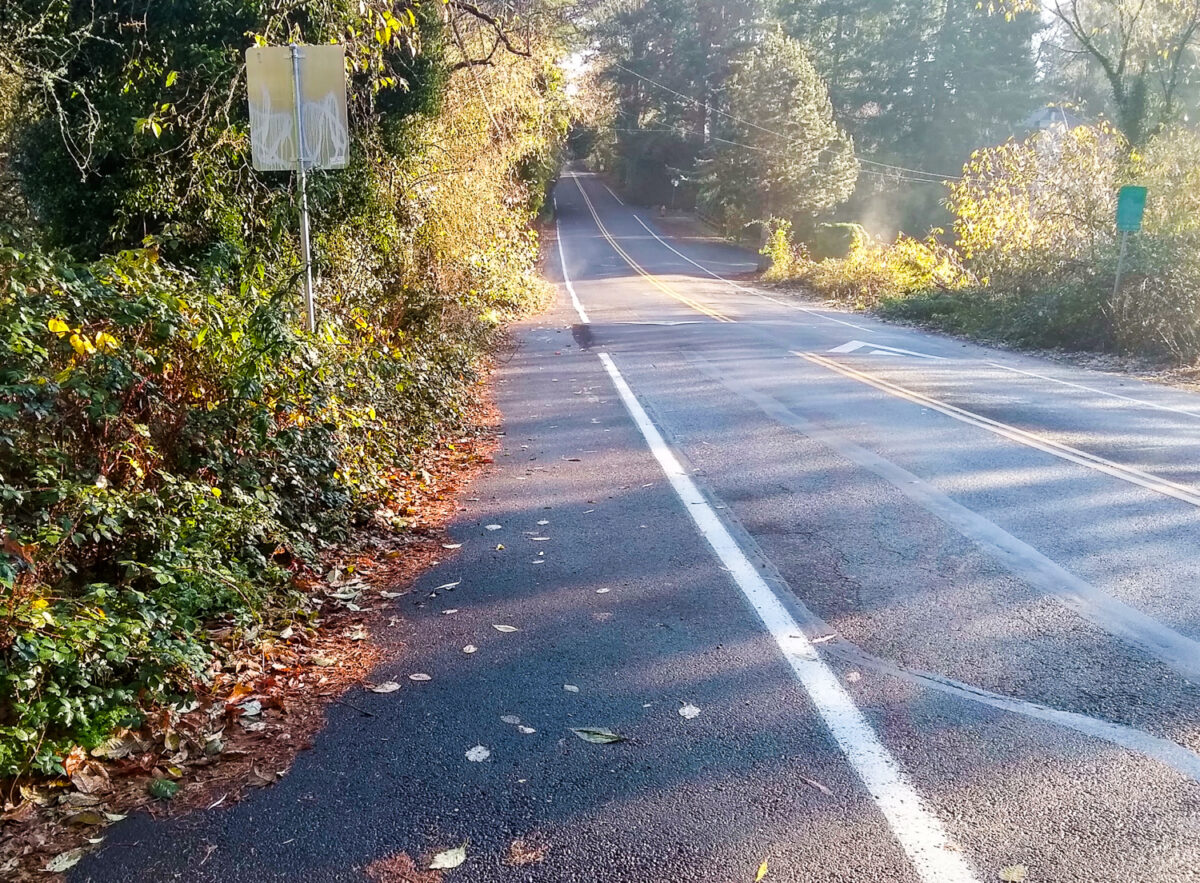
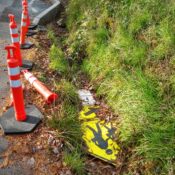
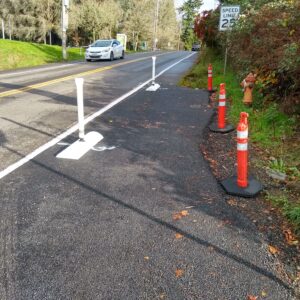


Thanks for reading.
BikePortland has served this community with independent community journalism since 2005. We rely on subscriptions from readers like you to survive. Your financial support is vital in keeping this valuable resource alive and well.
Please subscribe today to strengthen and expand our work.
I’m curious… why does the City think writing articles for BikePortland is not compatible with being Chair on the Bicycle Advisory Committee? Is it because he is paid for his writing?
I don’t get it either. There’s plenty of members of the BAC who are paid outside of their roles within the BAC, some even represent groups who have PBOT or other city contracts, some are even paid to attend the BAC by their organizations. The BAC members who are entirely unemployed or retired are rare.
Jarvis is listed as “Staff” and “President” on https://www.ortrucking.org/staff/. I assume that’s a paid position.
Merrill is an author, and possibly more, at https://ceic.cc/, which is every bit an advocacy group in favor of motor vehicles.
I’m not able to reconcile why BAC members would be under different employment or even advocacy rules than PFC members.
Fun fact about Jana Jarvis: if you look her up in the Oregon registry of lobbyists there is an active entry.
It’s sort of a long story that I’ve been meaning to share in it’s own post. But to put it mildly, the PBOT/BikePortland relationship has shifted a LOT over the years. They consider BP a news outlet, and they have strict policy (which might be less strict now because the guy who cemented the policy is leaving) that no city staff are allowed to talk directly to BP under any circumstances. Even friends I’ve had for years before the new policy went into place are afraid to talk to me even in casual settings… it’s absurd really. The policy applies to any media outlet technically, but given the close ties between BP and PBOT, it has a very big impact on us in particular and no other outlet in town covers them with the depth and frequency that we do. And recently, Office of Civic Life has tried to make all advisory committees more official so they consider leaders of them at “public officials” to some degree… And therefore I think PBOT is trying to say that as a public official who leads an advisory committee that is privvy to some insider info that is not intended for the media, it would just be untenable for David to play both of those roles.
I don’t think this conversation is over however. I’ve even yet to discuss this with PBOT myself directly and have let David manage his own affairs in this regard. Stay tuned.
That’s very disturbing on all kinds of levels. Do you think as a consequence we will get more anonymous insiders commenting on BP then?
Well hopefully in the near future we’ll have more PBOT sources both here in the comment section (by their real names!) and in stories. I’ve all but given up talking directly to the expert and wonderful staff because of how annoying it is to schedule and set up. I work on very short deadlines and not being able to just call/text/email staff and get quality answers has been making my job a lot harder (and my stories weaker) for many years now. There’s more to this story. I will write it up soon.
Yes, please do! Last week’s Wheeler story was bad optics and poor leadership, but it’s one of those things where I roll my eyes and go on with my day (I’m glad you published it). This story is a complete gut-punch to me. I’m still fuming days later. Portland, as a government from the Mayor and Council on down, claims to pride itself on citizen input and making decisions based on that input (from all quarters). This story tears out the heart of that pride and shows it for what it is: back-room cronies with power and wealth making all the calls, and “visions,” “plans,” and “citizen input” all purely window dressing. I don’t mean to slag PBOT’s “expert and wonderful staff,” I agree there are great people there. So far, this sounds like mid-to-top management chickenshit. Did that all happen after Treat left? I hope you’ll include Hardesty in that story, as the top-of-the-top. Her life experiences ought to tune her distaste for this sort of bureaucracy silently discarding the general public’s wishes which are outside of management’s (and cronies’) own perceptions.
Aside: David Stein, thank you for the excellent series. While this discussion wasn’t what you intended or expected, I think it’s a very valuable outcome. As I read your articles now with this greater knowledge of PBOT in the background (and hate to think of the corruption in the land use planning management!) it very much adds to my appreciation of what you are writing about. I interpret the things you say quite differently in this light than without it.
This isn’t what I wanted to talk about with this article and yet it seems to be the only thing being discussed. I’m not completely sure what I’m able to discuss publicly and silence is a different issue so this is what I’m comfortable talking about right now.
The primary citation is PBOT policy around talking with the media conflicting with the ability to inquire about projects or policies as a “public official.” It’s not worth the fight since it would be a distraction with little to gain.
Nothing in this situation is lost on me. While there’s much I’d like to say it’s best not to right now. There will be things that happen behind the scenes and hopefully they will lead to good things that can be reported about here.
Finally I want to put to rest compensation – there was none, I did this on a volunteer basis in an effort to avoid the previously mentioned conflict. There were many nights with little sleep as the articles didn’t write themselves which was part of my payment for this effort. My sincere thanks to Jonathan for his work improving the text I sent his way and understanding as events unfolded. I had hoped to do some updates on the big projects in SW as they really are significant but that will have to wait for someone else. It was fun to do something different and challenging.
I have come across many cities like Portland where the sidewalk construction and maintenance, plus the grassy strip in between, is up to developers and the property owners. Technically, all the land in the right-of-way is owned either by the city or on some streets, by the county or state, and the City of Portland has built many sidewalks after-the-fact, particularly the numerous WPA sidewalks of inner Portland in the 1930s and more recent projects in East and SW Portland.
I have come across many other cities, including the city I live in now (Greensboro NC) where the responsibility for sidewalk construction and maintenance, including the grassy strip, trees, and shrubbery, are left entirely to the city concerned.
I grew up in a community (Grand Forks ND) where the city engineer insisted that all developers had to put in all the roadways, sewers, sidewalks, and other utilities before any foundation could be begun – they had a near 100% compliance rate – developers simply got used to doing it that way, part of the cost of doing development in that community. Property owners then had to maintain the sidewalk area, and if they didn’t, the city would come in and do it for them and put the charge on their city utility bill, cutting off water if it didn’t get paid.
IMO, I can see Portland down the line imposing either by fiat or by referendum a citywide LID (local improvement district) much like that in Washington County whereby the city borrows money and/or uses SDC (system development charges) to build infill sidewalks along arterial and collector stroads where needed and charge property owners through liens, that is when the property next changes owners.
It seems like Portland is going to have to take on the responsibility of building sidewalks and other infrastructure on SW arterials and collectors at some point. Land divisions and infill development simply isn’t ever going to happen fast enough to link together needed infrastructure. And seeing as PBOT isn’t doing anything to actually make developers build their frontages when they are legally required to do so, it isn’t ever going to happen outside of some other process. That isn’t going to happen until and unless the people demand it and they hold their elected leaders accountable to make it happen.
Boyd, thank you for touching on the big picture of what is happening in SW Portland. It’s not about one development slipping through. The city of Portland rewrote its code to include a big loophole which lets savvy developers avoid requirements. Between that and the Nolan/Dolan court rulings, Development Review stopped requiring sidewalks in SW a few years ago. Three to six feet of shoulder now satisfies the sidewalk requirement:
https://bikeportland.org/2021/08/12/sidewalks-and-portland-its-not-so-simple-336493
With its «In Motion» work, PBOT Planning puts effort into fixing gaps and making active transportation enhancements; meanwhile PBOT Development Review apparently feels it lacks the support to enforce Portland’s policy for getting sidewalks built. It’s like trying to fill a tub with the drain open. That’s why Streets 2035 and the Pedestrian Design Guide are so important:
https://bikeportland.org/2021/10/12/streets-2035-and-pedestrian-design-guide-will-help-city-decide-who-gets-what-and-why-339712
David, thanks for this series. It’s issues like this that shine a light on the huge gap between the official positions of city and county agencies. (what they say) and the reality (what they do). Do they want to encourage biking and walking or not? By not prioritizing sidewalks and bike infrastructure, it appears the real answer is no. The other absurdity is the gap in encouraging transit use. Hamilton has a bus line and bus stops. How are people supposed to get to and from the bus stops? Presumably walking, but that puts people at risk and so it actually discourages people who might otherwise be interested in using public transit. Almost all the bus routes that traverse the hills have these pathetic, isolated bus stops that are dangerous to reach. Canyon Blvd? who in their right mind would walk to one of those bus stops and wait on a street that barely even has shoulders, while traffic zips by at 45 – 50 mph?
IIRC, ODOT is considering making a road diet on part of SW Canyon Road between near 87th Ave to where it ends by the county line. I’ve rode a bike uphill on Canyon Road, but it wasn’t pleasant in non-snow and ice weather. It was a better ride going downhill even in the snow.
That would be great. The amount of traffic doesn’t justify 4 lanes and just creates a racetrack mentality
There are some stops that might have a bench or a patch of asphalt though that is the exception and most are closer to your description. When the Rose Lane Project was before Council in February 2020, Commissioner Hardesty was quite concerned about the lack of bus shelters throughout the city. While her focus was on East Portland, and rightfully so, it could also apply to SW where so many stops are marked by nothing more than a steel post without a place to queue/wait to say nothing of ADA accessibility. This is also where TriMet being a separate entity makes the situation more challenging to navigate as there is no requirement to coordinate activities.
It’s not quantifiable the impact it has on ridership but it does send a message. The same way that installing a 3′ wide bike lane on Division as part of the new FX line through transit stops sends a message about the place bicycling resides in their modal hierarchy.
It’s downright incredible that any home put in or improved after 1990 didn’t require a sidewalk. Much less a new one where cost was literally no issue….but hey, this is Portland and corruption runs deep. Yeah, it’s corruption. Bless by bureaucracy. Somebody somewhere said “but the developer won’t like it”. All the while any visit to most small cities and towns find…well sidewalks. The most basic function.
The death of Portland by a thousand cuts…on one side lawlessness, on one side unimaginable wealth….pushing in with no leadership. Here is to hoping….for real change.
Well this is nuts. People that I know in the NE Cully neighborhood (I have this story straight from them) had a very different experience. They live on a street with perhaps 10% sidewalk coverage in a five block run. They built an ADU and that did not trigger sidewalk replacement. When they replaced an older 1-story house with a slightly larger 1-story house, owner occupied before and after, they had to pay for 100 feet of sidewalk, curb cuts, storm water inlets and drain pipe. Not cheap.
Cully needs sidewalks for sure. But, what applies to an existing, undivided property in NE should apply equally to newly subdivided properties in SW. It’s kind of like US tax law, there are layers of arcane rules and if you can afford to hack the system no sidewalks get built. It’s a shame.
In the SW, it has been my (limited) experience that a homeowner seeking to divide or redevelop an existing lot might be building a bunch of stuff; a developer will not be held to such standards, even if the project is huge and could engender much pedestrian traffic. First off, the developer will trot out studies that show 12 condos or whatever will mean just 10 or 12 pedestrian trips, and they couldn’t POSSIBLY justify the expense of a sidewalk etc for that tiny amount. The city will agree, nevermind all the people who might use it who do NOT live in those new houses. If you sit at an existing project of similar size and count all the pedestrians using sidewalks yourself, they will pat you on the head and say ‘you are not a paid expert’ and dismiss your data.
I am personally aware of 3 developments – two of which were adjacent to or one lot away from existing sidewalks! – which were simply required to make a shoulder; in at least one case the ‘impervious cover’ requirement was tripped and a sewer had to be put in for runoff – there was no reason not to make it a sidewalk at that point! Meanwhile, I know of one resident forced to put in frontage improvements which totaled some 10% of total cost.
The problem is simple: the development side of PBOT is hostile to anything that will add costs to developers, which means they are hostile to bikes and peds. Period. The city has gone so far as to change Code to allow developers to ignore ped/bike safety as a factor when permitting development.
I am morbidly curious to see what happens to the Pedestrian Design Guide update and Streets 2035, and how much their goodfaith efforts to improve safety are thwarted by the development side.
PBOT has an existential fear of being sued by developers. It needs to fear being sued by residents.
The clear presumption is that the people who live in new multi-unit developments are going to drive everywhere. Which they must because there is no facility provided for other modes of transport. It’s self-fulfilling.